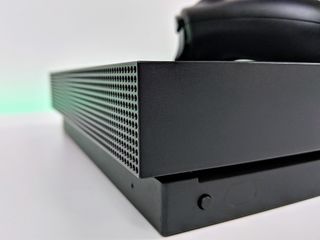Forget 4K — Xbox One X also delivers impressive upgrades on 1080p displays
The Xbox One X might be marketed as for gamers equipped for 4K, but its 1080p enhancements are also noteworthy.

Microsoft's latest video games console, the Xbox One X, is finally available, promising a premium gaming experience with a price tag to match. With 4K, HDR, and other visual enhancements being marketed alongside the device, the console has emerged as the most powerful on the market, surpassing its closest competitors in graphical fidelity.
Although the Xbox One X is best experienced with a 4K HDR display, the device also promises to benefit gamers with 1080p panels. With more consistent frame rates, reworked textures, and improved lighting effects all being common features of "Xbox One X Enhanced" games, many of these can also be experienced without a bump in resolution. Furthermore, 4K games can be displayed on lower resolution displays via a technique known as "supersampling."
Note: To view these image comparison slides, make sure you're viewing this page in a web browser and not our Windows 10 app. Some ad blockers have been known to break the image sliders in this story, so consider disabling them for this piece. This article is best viewed on a larger display — you're not going to see the differences while viewing on a mobile phone.

About supersampling and Xbox One X
Supersampling is a feature of the Xbox One X that's implemented specifically for those on lower resolution displays, rendering an output at a higher resolution than the display, before being downsampled down to 1080p. This essentially makes for a clearer image, with much smoother edges and shadows.
When Microsoft briefly discussed the benefits of supersampling at 1080p for the first time at E3 2017, I was doubtful of the concept, expecting little gain for those with full HD displays. While I understand the benefits of the technique and how it can aid the clarity of an image, I still had doubts about how a 1080p supersampled image would translate to a TV.
4K HDR is the biggest selling point of the Xbox One X, and without the aid of the console's flagship features, the talk surrounding the 1080p benefits felt like marketing speak. With Microsoft pushing a jump in resolution that's only slowly being adopted by the mass market, supersampling felt more like a way to market the console to a larger audience, rather than a valid way to experience the console's horsepower. And with Microsoft having scarcely pushed supersampling in its wider marketing prior to launch, my expectations for the Xbox One X in full HD remained dampened.


Star Wars Battlefront II on Xbox One S (left) versus the same scene on Xbox One X, supersampled to 1080p with enhancements (right). Note differences in foliage quality, character detail, and even UI clarity.
Get the Windows Central Newsletter
All the latest news, reviews, and guides for Windows and Xbox diehards.
In the days since the Xbox One X launch, we've had more time to get familiar with the console in a home environment. And as a part of that, I've briefly used the console with a 1080p display. In the time I've spent with the Xbox One X, my thoughts on its 1080p capabilities and appeal have quickly shifted. After seeing these enhancements in action, the Xbox One X now feels much more appealing through the eyes of a 1080p gamer.
For games that already hit 1080p on Xbox One, the benefits offered by the latest console may not be as outstanding. However, the benefits of supersampling don't only affect aliasing – downscaling a higher resolution image means that games with 4K assets are almost guaranteed to output a consistent 1080p image. And with consistent 1080p on standard hardware being an uncommon sight in the AAA space, this brings a significant visual improvement.
For me, these benefits were best brought to light by Star Wars Battlefront II – a game that fails to hit a consistent target resolution on standard Xbox One consoles. With Xbox One X enhancements available for this title, the changes over the standard Xbox One are clear, with general refinements across the board that complement its authentic art style. It's these games where a resolution bump and supersampling go hand-in-hand that show how the hardware's overhead doesn't have to go to waste below 4K. These changes aren't mind-blowing, but they are easy to pick up with a controller in-hand.


Star Wars Battlefront II on Xbox One S (left) versus the same scene on Xbox One X, supersampled to 1080p with enhancements (right). Note differences in environmental details and reflections.
What's it all mean for gamers with 1080p panels?
Upon first making the switch, the differences between Xbox One games on the two devices might not be as apparent. However, you'll soon begin to discover polish throughout games, with much more stable and visually-appealing versions of your existing experiences. They might not be stark at first but upon returning to an Xbox One S, the differences are clear.
After playing several "Enhanced" titles across the two devices, the Xbox One X has the potential to prove itself as a noticeable upgrade on lower resolution displays. Obviously, 4K is still going to offer a superior experience for almost any title, but don't be so quick to dismiss the Xbox One X as a 1080p gamer.
The Xbox One X is an expensive piece of kit, and by investing in it you're aiming to receive the best gaming experience across the Xbox family for your display. As seen with several titles, there are real benefits to be had without a 4K HDR display. The $499 price point is steep, but you'll be futureproofing your console for the years ahead – just maybe not with a dramatic leap to start.
Matt Brown was formerly a Windows Central's Senior Editor, Xbox & PC, at Future. Following over seven years of professional consumer technology and gaming coverage, he’s focused on the world of Microsoft's gaming efforts. You can follow him on Twitter @mattjbrown.

